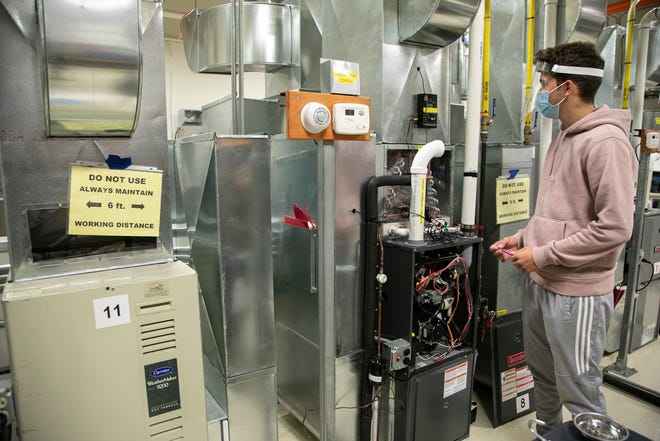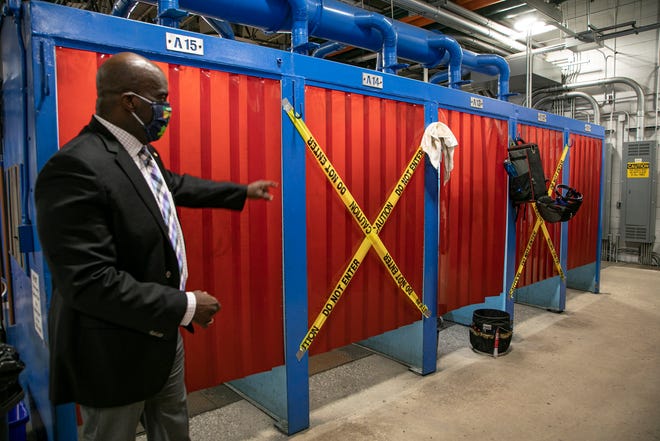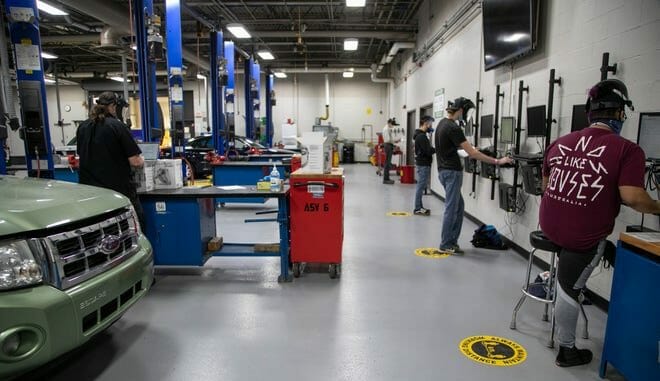6 Months to a Good Paying Job? Short-Term Credentials
For decades, students have been flowing into welding — and other hands-on trades — in labs in Michigan’s community colleges, seeking training needed to garner credentials that allow them entry into the workforce. In recent years, state officials have been pushing these short-term credentials — those taking under two years to earn and often less than a year — as a way for students to get some postsecondary training as a way to improve their incomes. That includes Gov. Gretchen Whitmer, who has set an aggressive goal of increasing the percentage of Michigan adults who have some sort of post-high school credential or degree from 45% to 60% by 2030.
But in a pandemic world, questions remain. Will students be able to access this training? Will certificates tied to a specific industry work when that industry goes through a downturn? Are they a key to combating poverty, especially in rural Michigan?
“Our enrollment is down, because of COVID,” said Jimmie Baber, the dean of advanced technologies and public service careers at Washtenaw Community College. “We don’t know how long it will be.”
The argument being made for pushing more people into these short-term credentials is simple: If you want to be employed in a job that pays even a modicum of a living wage, you need some sort of post-high school training.
It’s a valid argument, data from the state shows. Those with a certificate gained after less than two years of study make more, on average, the first year after graduation than those with just a high school degree and even those with a two-year associate’s degree. Five years after graduation, those with associate degrees and those with certificates are about even in average wages, about $15,000 a year more than those with a high school degree.
How it works in a pandemic
Entering the Washtenaw Community College building where trades are taught follows a now-familiar process. First, fill out a form on a smartphone, certifying no exposure to COVID-19. Then, enter the building, stopping at the front desk, where student workers are sitting behind plexiglass. Show them the completed form, get temperature taken and then proceed down the hallway. In the lab/shop/classroom, follow the directional arrows, observe the safety precautions on the big signs and then start learning.

But don’t expect the classroom/lab/shop to be overflowing with students. WCC is on an alternating schedule where only half the class is in the lab/shop at a time. The other half is watching recorded lectures and doing other out-of-the-classroom work. The community college has also limited the number of people taking a class.
“We’re having to be as flexible as we can be,” said WCC HVAC professor Robert Carter. “We had to change the way we were teaching. We’re trying to make the most of the time they have in here (the college’s shop/lab). It’s very fluid.”
There are changes even in the work spaces. In the welding classroom, every other booth is taped off with bright caution tape. Each day, the booths that are open change in an effort to keep everything clean and people separated. In the HVAC (Heating, Cooling, Air Conditioning) classroom, it’s the same — a row of furnaces is down to every other one being open to be worked on.

With half the equipment available, there’s only half the spots available for students. That’s hurting enrollment for the simple fact there aren’t as many spots available.
Also with potential to hurt enrollment in short-term credential classes is the uncertainty of time available to take classes, Baber said. Imagine a family with children, where mom or dad used to be able to work one job and then go to a community college. That might not work out now because the children in the house can’t go to their own school and need someone to be at home with them.
Michael Talma, 24, of Ypsilanti, was hoping be in classes at either Washtenaw Community College or Wayne County Community College District this fall, working on certification as an auto mechanic, but never got the chance to, thanks to the economy.
“I was going to keep working (a full-time retail job) and then go to school,” he said. “But then my hours got cut there this spring because there was no work, so I had to get this second job (working fast food) just to pay for rent and food. There wasn’t any time left to go to any program, even if I would have had the money.”
A ticket out?
On a cold February morning, back before COVID-19, when students were able to mingle before class and stand close to each other during instruction, Breann Poszwa, Jerilyn Bartys and Ashley Belcher gathered around a table draped with a surgical cloth and holding just about every possible tool that could be used in a surgery in a classroom at Kirtland Community College in Grayling.
While the future pay was attractive, so was the program’s length.
“It was the quickest program and it interested me,” Poszwa said. “I want to be able to start my career as soon as I can. When you’re not financially that stable you want to get into working as soon as you can.”
There aren’t a lot of jobs across rural Michigan and not a lot of access to college training. Huge chunks of rural Michigan are in education deserts.
Those rural counties are also among the poorest in the state in terms of average household income.
So getting a good job, and getting the training for a good job, can be a struggle.
Many of Michigan’s community colleges are offering programs tied to local industry. The colleges train the workers on the machines needed to run the business and the companies get a trained workforce.
At Kirtland, the college recently started a wood science program. It takes students nine months to complete. When they come out they are certified to work as woodworking machine setters, operators and tenders. Those are jobs that can start just under $30,000 a year.
The programs offering quick credentials are also stackable, meaning students can come back and add on to work toward an associate degree or add additional credentials allowing them to work on different types of equipment.
The colleges are also working with dual-enrolled students who are going to high school and community college and will leave high school with a credential allowing them to go directly into the workforce.
“There’s just something fun about trying to join one piece of metal to another piece of metal and making something,” Jacob Holt said in mid-January during a welding class at Mid-Michigan College. “This is what I want to do (for my career).”
The short-term credential helps employers know a job applicant has the skills needed, Shawn Troy, the dean of career and workforce education at Mid-Michigan, said.
“Employers want to make sure (applicants) have the skills,” he said.
More than 9,900 undergraduate credentials less than an associate degree were awarded in Michigan in the 2018-19 school year, up from 9,500 the year before, according to data collected by the state. More than 2,700 of all certificates were for health-related careers. Also popular were precision production, 506 certificates; machine and repair, 621 certificates, and engineering technologies, 586 certificates.
“We know the demand is there for the jobs,” Baber, of Washtenaw Community College, said. “It’s not going away. It keeps growing every year. We need to make sure people are able to get the training they need. We also need to battle the idea that a four-year degree is the only college and it’s for everyone. There’s great training opportunities here.”
This report was funded through the Education Writers Association fellowship program. David Jesse is a 2020-21 Spencer Education Reporting Fellow at Columbia University and the 2018 Education Writers Association’s best education reporter. Contact him: 313-222-8851 or djesse@freepress.com. Follow him on Twitter: @reporterdavidj. Subscribe to the Detroit Free Press.
David Jesse Detroit Free Press
https://www.freep.com/story/news/education/2020/10/08/jobs-michigan-trades-community-college-training/5855717002/

